iHeartDogs is reader-supported. When you buy via links on our site, we may earn an affiliate commission at no extra cost to you.
Homemade dog food recipes are becoming popular among pet parents. When properly balanced, a homemade diet can be healthier for a dog than store-bought, especially if that dog is sensitive to certain ingredients. However, making dog food isn’t a task you can start with the snap of your fingers. It’s a process that needs lots of planning, preparation, and veterinary advice.
If you cook an unbalanced diet for your dog, they could face serious health concerns as a result. Thus, you should talk to your vet before making homemade meals for your dog. For help formulating healthy, balanced dog food recipes, check out balance.it, a site that helps you create safe personalized meals for your furry friend.

Choosing Ingredients for Homemade Dog Food Recipes
Some ingredients are great to include in dog food while others can be dangerous. So, you’ll need to select ingredients carefully based on your dog’s preferences and sensitivities. Talk to your vet for the most accurate breakdown of what your dog’s homemade food should include.
Beneficial Ingredients
Your dog needs proteins, fats, carbohydrates, fiber, vitamins, and minerals in their diet. Protein is a crucial part of a dog’s diet because it promotes healthy growth and energy. The most common protein sources for homemade food are turkey, chicken, beef, and pork. Any meat you use should be plain, without added seasonings or spices.
If you don’t have enough fatty acids in your recipe, you can use fish oil or plant-based oils for a health boost. Then, veggies like carrots, pumpkins, and dark leafy greens can be used to add fiber. For carbohydrates, many dog parents use rice or potatoes because they’re easy to digest and also a great source of fiber.
Related: Best Rated Fresh Dog Food Companies
Ingredients to Avoid
When we make foods for ourselves, we tend to add a lot of seasoning to make them taste more appealing. However, many seasonings, especially garlic, can be toxic to dogs. Other toxic foods to avoid include chocolate, grapes, xylitol, and onions. When it comes to dog food, plain and simple is always safer. Of course, if your dog has any allergies, be sure to avoid those ingredients at all costs.
Best Homemade Dog Food Recipes
Below are a variety of homemade dog food recipes using different proteins to help you get started with DIY pet diets. For how to make homemade dog food recipes, click on each link for more information.
Homemade Chicken Dog Food Recipes
1. Chicken Homemade Recipe with Carrots and Sweet Potatoes
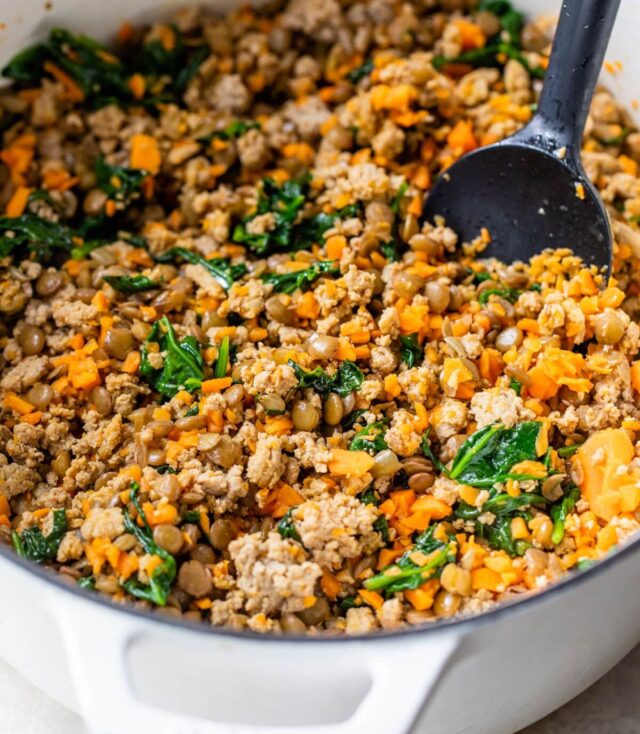
It only takes 30 minutes to prepare and cook this homemade recipe. While chicken or turkey is recommended as the primary protein, almost any meat source can be used. Then, the recipe includes carrots for added potassium, fiber, and antioxidants and sweet potatoes for vitamins, calcium, potassium, and iron. Once it’s all mixed, it may look so good that you’ll mistake it for a human meal.
2. Easy Crockpot Recipe with Ground Chicken
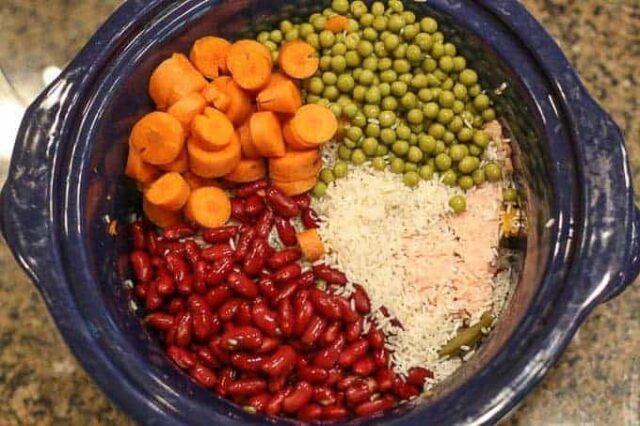
Cooking isn’t easy and fun for all dog parents, but that doesn’t mean they shouldn’t be able to serve homemade food. This recipe makes DIY meals easier because all you have to do is prepare the ingredients and then throw them in a crockpot. It will take a few hours for the food to cook, but it requires minimal effort from you. When gathering the ingredients, it’s important to choose lean, ground chicken and vegetables with little to no sodium.
Homemade Turkey Dog Food Recipes
3. Ground Turkey and Rice Homemade Dog Food
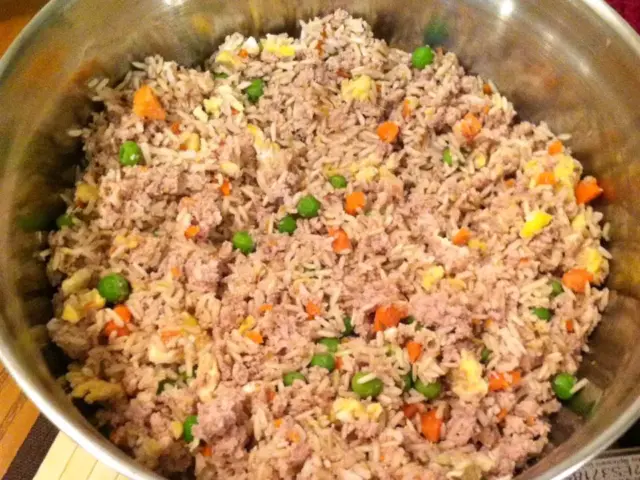
Turkey is a popular protein for dog food because it’s lean, low in fat, and high in amino acids. This recipe works best with turkey as the primary protein, and then it’s paired with brown rice, rosemary, and vegetables. It can be made in about 30 minutes, and it will make most dogs’ mouths water. If you’re not ready to switch your dog to only homemade food, you can use this recipe as a food topper to mix with kibble.
4. DIY Dog Food with Turkey, Rice, and Vegetables

Even if your dog isn’t crazy about vegetables, they’ll find them hard to resist when they’re mixed with turkey in this savory recipe. The author of this recipe started her dog on homemade food after he faced digestive issues and the vet recommended a bland diet. The food ended up being so successful that they kept making it. So, whether your dog has tummy troubles or not, this can be a good recipe for dog parents who are trying homemade dog food for the first time.
Homemade Beef Dog Food Recipes
5. Beef and Veggies Homemade Dog Food

This recipe is great for picky pups because most dogs lick the bowl clean after eating it. The author of the recipe has a dog who’s allergic to chicken, so making homemade food ensures that there are no chicken products in the meals. This recipe uses beef as the primary protein, which is followed by rice and a variety of vegetables. If your pup is sensitive to most store-bought food, this could be a safer alternative if portioned right.
6. Homemade Dog Food with Beef, Brown Rice, and Eggs
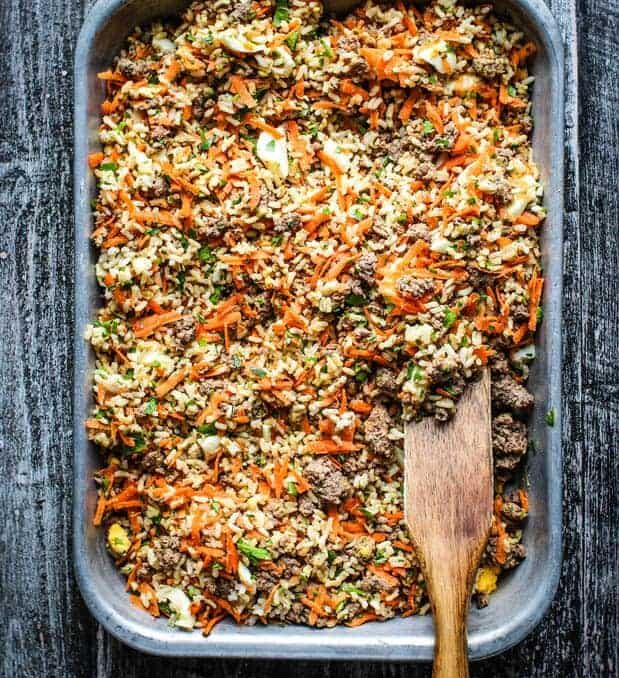
The person who made this recipe makes sure to note that she consulted her vet first before formulating the recipe, as all dog parents should when creating a homemade dog meal. It’s a 100% human-grade diet, but the ingredients are plain to protect sensitive dogs. It takes an hour to prepare and cook, but the time will be well worth it when your dog gets to try the beef, rice, eggs, and vegetables for the first time.
Homemade Pork Dog Food Recipes
7. Pork Adult Dog Food with Vegetables
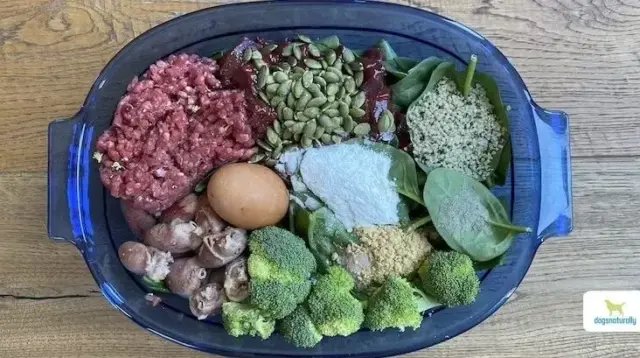
You can choose whether you want to cook this food or serve it raw. Both options produce a balanced diet for dogs. Pork is the main protein, but you can add more than one meat if you’d like, such as beef, turkey, or chicken hearts. Some of the other ingredients include spinach, eggs, broccoli, and pumpkin seeds. So, any pups who receive this meal will have a variety of flavors to enjoy.
Vet Approved Homemade Dog Food Recipes
8. Simple Recipe For Digestive Issues
If your dog is facing digestive problems like diarrhea or flatulence, Dr. Ihor Basko suggests making food with plenty of prebiotics and probiotics to balance your dog’s GI tract. Here’s his suggested recipe:
Ingredients –
½ cup chicken breast or lean steak
1 cup rice
½ cup coconut milk
2 tablespoons fresh dill
½ teaspoon ginger powder
½ cup water
“Bring to a boil and simmer until the rice is cooked. The dill will relax cramping in the gut from diarrhea and the ginger powder will fight inflammation and nausea. Add a probiotic that contains prebiotics such as Protegrity GI. Once the problem is gone, prevent future issues by adding prebiotic foods to their diet.”
9. MSPCA-Angell Sample Dog Food Recipe
These recipes were balanced by a Certified Veterinary Nutritionist, who confirmed that these are safe for dogs when given as directed, as long as your dog has no unique medical needs. There are recipes for 15-pound, 30-pound, and 60-pound dogs. Plain chicken and rice are the primary ingredients in these recipes. MSPCA-Angell created the recipe because a lot of pet parents have been concerned about pet food recalls, so making balanced homemade dog food can help ease those worries.
Related: 7 Best Dehydrated Dog Foods
Things to Consider Before Making Homemade Dog Food
After talking to your vet, any of the above recipes could be a great choice for starting a homemade dog food diet. Yet, there are a few more aspects you should consider.
A Gradual Transition
Homemade dog food is very different than kibble, so you can’t just switch the food without warning because it could cause digestive issues. So, when switching your dog to a new diet, you should do it gradually. Here’s a suggestion for how to transition a dog’s food:
- Days 1 to 3: Serve 80% old food with 20% new food
- Days 4 to 7: Serve 50% old food with 50% new food
- Days 7 to 14: Serve 20% old food with 80% new food
- Day 15: 100% new food
If you’re worried your dog won’t handle the new food well, you may want to consider using the homemade food as a topper instead of a full meal. That way, your dog can still get extra flavor and nutrients from it, but they never have to get rid of their old food completely.
Portioning the Food
Like with any food, serving sizes are important for your dog’s health. Since homemade dog food doesn’t have a nutrition label like store-bought food does, you’ll need to do your own research to find the proper portions. Most recipes list the recommended servings based on weight, but asking your vet is the best way to confirm a serving size.
If you don’t already, consider buying some pet-specific measuring cups for portioning the food. Many dog parents prefer collapsible ones because they’re easier to store. After every time you use the measuring cups, make sure you wash them to prevent bacteria from spreading.
Storing the Food
Once you’ve made the food, put all the extras in an airtight storage container. If your homemade dog food looks a lot like human food, you may want a container that’s specifically labeled for dogs. If you’d rather pre-portion your dog’s food, you can get a pack of reusable storage containers to separate your dog servings.
Then, you can keep the container in the fridge for about four days or you can freeze the food for up to six months. The storage time varies based on the recipe.
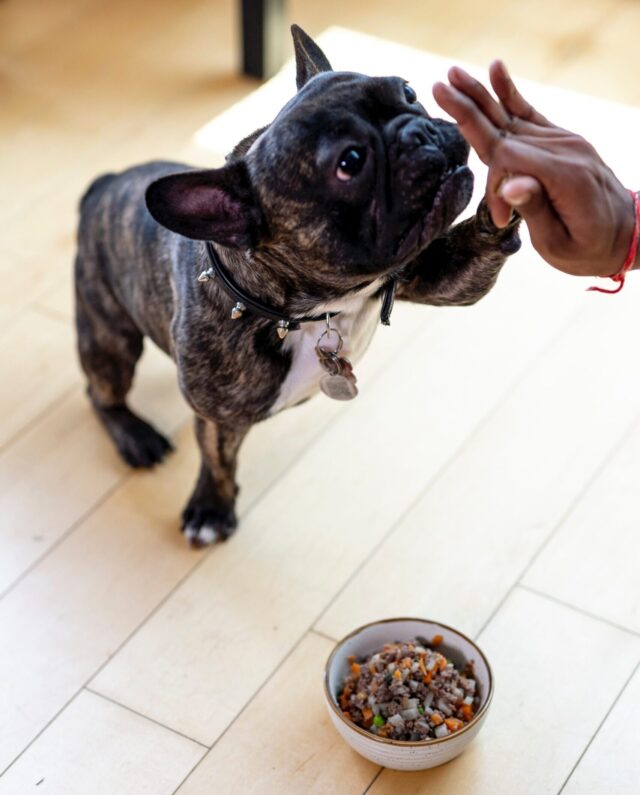
Frequently Asked Questions
What Ingredients Should Be in Homemade Dog Food?
Your dog needs ingredients from the following categories: protein, fat, carbohydrates, fiber, vitamins, and minerals. Those often include meats, vegetables, and grains. The exact ingredients can vary greatly depending on your dog’s needs and preferences.
What Should You Not Put in Homemade Dog Food?
Avoid foods that can be dangerous to dogs, such as chocolate, xylitol, grapes, onions, avocados, raisins, garlic, and macadamia nuts. Don’t put any type of seasoning on the meats and vegetables in the recipe because plain food is the safest for canines.
Is it Better for Dogs to Eat Homemade Dog Food?
Yes, homemade can be healthier for dogs than store-bought, but only if it’s a balanced diet with healthy ingredients. Before switching your dog to a DIY diet, talk to your vet to ensure you’re doing it right.
Is Homemade Dog Food Safe?
If it’s a balanced diet with proper ingredients, homemade dog food is safe for dogs. However, if you try to formulate a recipe without talking to a vet and doing proper research, you could put your dog at risk of many health concerns.
What Meat is Best for Homemade Dog Food?
The best meats for homemade dog food are chicken, turkey, or beef. However, any meat can be beneficial as long as you portion and prepare it right, so choose a protein source based on your dog’s preferences.
Is Homemade Dog Food Cheaper Than Store-Bought?
The price of homemade dog food varies based on the ingredients you use. In many cases, it’s cheaper than commercial food, but it’s much more time-consuming to prepare. So, you need to decide if the extra time is worth the more affordable cost.
Can Homemade Dog Food Be Frozen?
Yes, most homemade dog food recipes can stay frozen for up to six months. Before you serve frozen food to your dog, move it to the fridge to let it thaw for about 24 hours.
Related: Nom Nom vs Farmer’s Dog Fresh Dog Food Comparison

Final Thoughts
Homemade dog food recipes are a safe, healthy choice for many dog parents because they can help you feel confident about what’s going into your dog’s tummy. Dogs with sensitivities and allergies often do great on a homemade diet. However, getting started can be tricky for dog parents who aren’t used to making their dog’s food.
Before serving your dog homemade food for the first time, consult your vet to ensure that you can create a recipe that’s balanced and nutritious. You can also use balance.it as a tool for crafting recipes that are suitable for your dog’s specific needs.
Want to stick to pre-made dog food? Check out the 8 Best Dog Foods of 2024.
 Toledo, United States.
Toledo, United States.